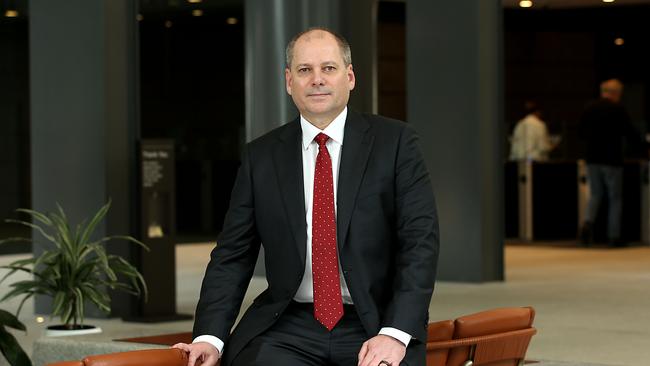Westpac flags huge cost cuts, more branches to go
Westpac chief executive Peter King has flagged a bold plan to slice $2bn in the bank’s costs by 2024.

Westpac chief executive Peter King has flagged a bold plan to slice $2bn in the bank’s costs by 2024, including cutting branches, head office staff and space, as it steps up a simplification drive to navigate a tough earnings climate.
Westpac on Monday said its exit of non-core divisions and a shift to digital transactions would help it push costs lower, to $8bn by 2024, from about $10.2bn currently, excluding notable items.
Branch closures and mergers are part of the plan, which also includes reducing third-party and contractor spending by about $200m annually and cutting head office employees and space by more than 20 per cent.
Mr King said he was taking a “harder line” on costs, and that included putting clear targets around Westpac’s plan.
“I want to signal that Westpac is serious about this,” he said in an interview. “I’ve made it a company goal obviously, but it just helps to get alignment between what you’re doing with your external stakeholders, particularly shareholders and internally.”
Westpac’s $8bn cost target aligns with a number ANZ disclosed to the market in 2018 — to reduce its annual costs to $8bn or less.
Westpac still expects costs to edge up until the end of its financial year on September 30, before starting to decline.
The cost plan was outlined as Westpac handed down a better than expected interim profit result.
Last year, the bank had to pay a record $1.3bn settlement to financial crimes regulator Austrac for anti-money-laundering shortcomings and has had to increase spending to fix its compliance systems.
Westpac outlined investment of $3.5bn-$4bn over three years, but divestments, digitisation and the broader cost-cutting drive are expected to result in overall costs falling.
Mr King would not give specific numbers on how many branches could be axed as part of the cost-cutting blueprint, but said those in metropolitan areas would be targeted more frequently for closure.
“We think there’s opportunity in the metro areas in particular and metro sites tend to be roughly double times the cost of regional sites,” he said. But although transactions in branches are expected to tumble by 40 per cent by 2024, that would not equate to a similar size reduction in its network of 889 Australian branches, he said.
Two years ago, Westpac had 971 branches around the nation. So far this year the bank is working through closures for 39 metropolitan branches and one regional branch, but says all those locations have an alternative branch about 5km away.
Mr King said bank branches still had a future, although were changing and they would tend to be smaller and focused on digital and video channels. “The role of the branch will be different. The role of the branch will be less about service and maintenance and more about helping people at certain points,” he said.
Westpac is also merging branches by co-locating its brands — which include St George, Bank SA and the Bank of Melbourne — together where it made sense. Mr King remains committed to the multi-brand strategy.
CLSA analyst Ed Henning said he expected the “main drivers” of Westpac’s cost-out to be digitisation and simplification, as well as exiting businesses.
Citigroup analysts suggested Westpac was scant on cost-cutting details, given they could trigger a backlash against the bank.
“Some of these cost buckets could prove politically sensitive to prevent their more fulsome disclosure,” they said.
Finance Sector Union national secretary Julia Angrisano said Westpac’s simplification agenda equated to more branch closures and job losses.
“There is real concern among staff at the Westpac Group, including St George Bank, Bank SA and the Bank of Melbourne, that their branches will be the next to close and they will be left without jobs,” Ms Angrisano said.
Westpac’s cost-cutting plan sees all mortgages processed on a digital origination platform by 2024, compared to 62 per cent currently. It also wants 70 per cent of consumer sales to occur via digital channels and to slash the number of products it offers by more than half to 345 by 2024.
“The economy is digitising so for the banks we’re going to have to be part of that journey,” Mr King said.
The bank is reducing the number of offices it has outside Australia and expects its divestment program will see it shed seven businesses in three years. Westpac has already sold several divisions, including financial advice, general insurance and its Pacific operations, and is seeking to divest other businesses, including its life insurance arm, auto loan book and investment platforms.
Mr King said there were about 5000 staff working in units that were slated to be sold and he hoped “many of” those would transfer to new owners as transactions completed.
He said that, over time, Westpac’s head office would reflect a smaller bank.







To join the conversation, please log in. Don't have an account? Register
Join the conversation, you are commenting as Logout